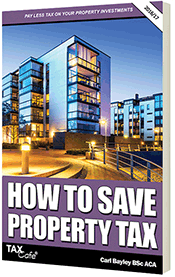Stamp Duty Land Tax:
Urgent Action Required
Stamp Duty 'Holiday' Coming To An End
IN SEPTEMBER 2008 the threshold at which Stamp Duty Land Tax (SDLT) begins to be charged on purchases of residential property was temporarily increased from £125,000 to £175,000. Since then, the increased threshold has provided purchasers with savings of up to £1,750.
The latest stamp duty and other tax planning information can be found in our guide:
How to Save Property Tax
Sadly, this so-called ‘holiday’ will come to an end on 31st December 2009, after which a residential property purchase for just £125,001 will give rise to a SDLT bill of £1,255. There is an exception for property in designated disadvantaged areas, where the threshold will return to its former level of £150,000.
Commercial property is unaffected by these changes and has retained its previous SDLT threshold of £150,000 throughout the so-called ‘holiday’.
The obvious planning issue is that purchases of residential property for anything between £125,001 and £175,000 need to be completed by 31st December 2009 in order to avoid SDLT.
Anyone considering transferring residential property into their own company should also heed this deadline. SDLT is payable on the property’s market value in these cases. If that value lies between £125,001 and £175,000, making the transfer by 31st December 2009 could save you up to £1,750.
The Effective Date
In order to secure the benefit of the SDLT ‘holiday’, the ‘effective date’ for the property purchase must be no later than 31st December 2009.
Merely entering into a purchase contract (or exchanging missives in Scotland) is not sufficient: the ‘effective date’ is the earlier of the date of conveyance or the ‘substantial completion’ of a contract. Substantial completion takes place when the purchaser either takes possession of the property or has paid 90% or more of the purchase price.
However, there is generally no substitute for completing the conveyance by 31st December 2009 since, even if the contract is substantially completed before then, a second ‘effective date’ arises when the conveyance takes place. If that second date falls after 31st December 2009, SDLT will be due whenever the purchase consideration exceeds £125,000.
In short, to benefit from the SDLT exemption on purchases of residential property for between £125,001 and £175,000, you will need to complete the conveyance by 31st December 2009.
The only other possibility would be to ‘substantially complete’ the contract by 31st December 2009 and never actually carry out the conveyance. This would rarely be suitable for a residential property purchase and has major legal implications on which professional advice should be sought. Frankly, for a maximum saving of £1,750, it’s probably not worth it.
Leases
Property leases are also subject to SDLT when the total ‘net present value’ of the rent payable over the entire term of the lease exceeds the SDLT threshold. The ‘net present value’ is calculated by applying a discount factor of 103.5% to each year’s rent (e.g. annual rent of £10,000: first year’s net present value is £9,662, second year is £9,335, etc).
SDLT can be avoided on a new residential property lease with a net present value of no more than £175,000 by commencing the lease by 31st December 2009. Thereafter, SDLT will be payable at 1% on the amount by which the net present value exceeds £125,000. The maximum saving is just £500 but it’s still better in your pocket than in Alistair Darling’s!
Linked Transactions
Where two or more properties are purchased together, they are effectively treated as a single transaction for SDLT purposes.
For example, a property investor buying three properties from the same developer at the same time for £55,000 each would be treated as having made a single purchase for £165,000. Completing the purchases by 31st December 2009 would save the investor £1,650 in SDLT.
Commercial Property
31st December 2009 is also a key deadline for many commercial property purchases. Although the SDLT rates for commercial property will remain unchanged, the increase in the VAT rate from 15% to 17.5% on 1st January 2010 will have a major impact.
This is because many commercial property sales are subject to VAT and SDLT is payable on the VAT-inclusive price. You may subsequently be able to recover the VAT (e.g. by opting to tax the property), but the additional SDLT is a permanent, irrecoverable cost.
For example, let us suppose that you agree to buy a shop for a net price of £430,000, before VAT and SDLT. The previous owner has opted to tax the property so they must charge you VAT. If the sale takes place by 31st December 2009, they will charge VAT at 15%, i.e. £64,500, giving you a VAT-inclusive purchase price of £494,500. The SDLT payable on the purchase at 3% will then be £14,835.
If your purchase is delayed until January 2010, however, the VAT rate applying will be 17.5%. The VAT on your purchase will then amount to £75,250, bringing the total VAT-inclusive price to £505,250. This pushes you into the 4% top rate of SDLT, giving you a charge of £20,210.
Delaying the purchase until after 31st December 2009 will therefore have cost you an extra £10,750 in VAT and an extra £5,375 in SDLT. You may be able to get the VAT back but you cannot recover the SDLT.






